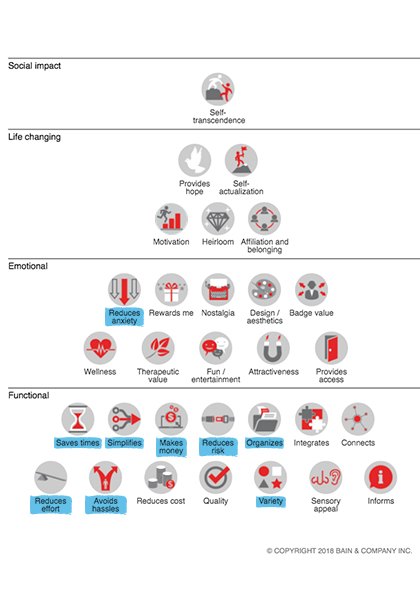
Creating and Managing Value
I continue to think about creating value for our customers.
Maslow's pyramid of needs is one of my favorite diagrams that explains a lot.

I think Maslow has done a great service to humanity. The best proof of human beings having a complex structure. In fact, these days while struggling with the pandemic, even though we have come by some new problems regarding the needs below the pyramid, I prefer to reason this as a necessity of life and look forward to focusing on the future. At the end of the day, everything transforms, first and foremost what we need.
If we evaluate it in terms of our own agenda, our matter is to create value for our customers and to establish an emotional connection. We focus on understanding what our customers really want. For this, we have an effort to firstly look at the data and then to turn the data into knowledge and gain. But it's not that simple to determine what customers really value, and it's also psychologically complex. So how can we effectively manage the value we create as a customer-centric company? How can we create more value, functionally or emotionally?
Analyzing different components such as product features, market information, price; and applying research methods to determine the need will be useful. However, we can say that these are the evaluation criteria we have been using for years and are used in a tendency to measure the reactions of customers. We also need to play a guessing game about what customers will value.
Bain&Co is a consulting firm that has written the book on customer experience, so to speak, and generates important ideas. I came across the "value component pyramid" of this team also inspired by Maslow, in an article published last year on HBR. A study conducted in 2015. With more than 30 years of experience, Bain&Co has identified 30 core value components in this study. Their aim is to create a technique to identify the real motivation underlying customers' preferences.
There is a bottom-to-the-top description in Maslow's hierarchy. He states that if you are unable to meet the needs under the pyramid, you will not be able to get to the top. That's quite logical. If you're not getting full in the stomach, you don't mind having social relationships or devote time to philosophical thinking about self-actualization.
My aim is not to give a thesis. I seek to understand and apply how to benefit from this information in practical life for our company. The pyramid has 4 main categories. As Ford Otosan, we are implementing highly successful products and services in the “functionality” category. Let's have a look at whether we can benefit from the Emotional Benefit, Changing Life, and Creating Social Impact categories, in terms of being able to create predictions about our customer expectations.
Let's consider an example.
During the pandemic period, we activated the "door-to-door service". Our customers who did not want to leave their house during the pandemic period called our call center to make a reservation. Let's see what kind of a value we created with this service, which we can summarize as follows: Our related dealer receives our customer's vehicle in accordance with the hygiene rules, contacts our customer with a video call, makes the required procedures on the vehicle and leaves it at the door.
In terms of functional benefit, it can be seen that we have covered quite a lot of components, especially related to the period. However, the value created in the emotional category does not go beyond "decreasing anxiety". It would not be too right to think that we are creating value for the customer in “Changing Life” or “Social Impact” components.

(Bain&Co's "value component pyramid". You can reach the original pyramid at: https://media.bain.com/elements-of-value/#. You can see the benefits of our "door to door" service marked in blue.)
Well then; should every service, every product be like this? Let's agree on one thing. This is a perspective, an approach. This service put into use had a great periodic benefit. In this sense, had a strong emotional bond. But what questions should we ask ourselves now; while continuing to provide this service? How do we think of asking these questions? As I have stated, this is a perspective and I consider this perspective as important, for us to strengthen our muscles in "customer-centricity".
Coming to a conclusion, there is a formula for “Customer Experience”. How good the experience depends on; how much you can divert the difference between the performance observed by the customer and the performance expected according to previous experiences. In all cases where we cannot exceed expectations, the best result is "satisfaction". Of course, this is very valuable, but if our goal is to create an emotional bond, we have to strive to do better than each and every time we come into contact with our customers.
Experience = Observed Performance - Expected Performance (by permission of CCXP Gökhan Kara)
Before I finish... As someone who prefers a dialogue rather than a monologue, I would like to repeat my question. Let me add that I will eagerly await your answers.
How can we effectively manage the value we create as the representatives of a company that cares and targets customer-centricity while doing our jobs? How do we design services that strengthen our emotional bonds and change the lives of our customers without giving up on the practical benefits of functionality? If creating social impact is the ultimate goal, what should we focus on for our products and services to achieve this?
Taking this opportunity, I wish everyone a wonderful year that we will spend in health and peace.
See you later!












